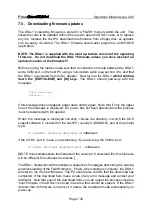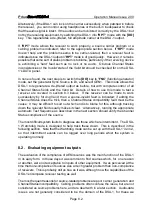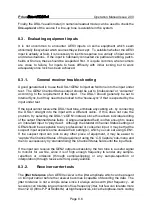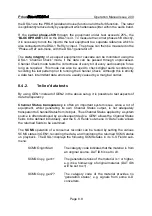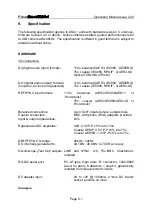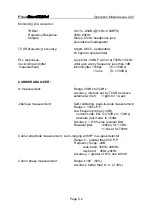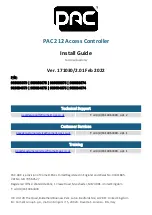
Prism
Operation Manual Issue 2.00
Page 8.4
8.2.2.
Source carrier tests
The sampling-rate accuracy of a source should be checked if the source is operating
as a clock master. This is usually only relevant in determining whether other equipment
will have sufficient range to lock to the source. Contrary to popular belief, there is no
connection between the absolute frequency of a synchronisation source and its
'stability' or jitter performance, which may affect the audio quality of non-jitter-
attenuating conversion equipment synchronised to it. In general, good quality
professional equipment should provide master sync within ±10ppm, and lower grade
professional equipment within ±50ppm. Equipment designed to provide a reference
clock should generally be within ±1ppm, and thus will usually be more accurate than
the DSA-1's own reference, unless the DSA-1 is fitted with the ±0.5ppm reference
option or has recently 'learned' an accurate reference source. Low grade consumer
equipment is generally permitted to be up to±1000ppm adrift when clocked internally,
although it is very rare nowadays to find examples anywhere near this limit.
The carrier amplitude of a source should be checked to be within reasonable limits
according to its electrical output format. However, it should be noted that a very wide
range of voltages is permissible - in practice, lack of carrier amplitude is almost never
the cause of a problem, unless long and lossy cables are used, in which case data jitter
would probably dominate in any case.
Likewise the source impedance can be checked, but is unlikely to be responsible for
any practical failures. Early equipment was often not source-terminated at all, and
generally presented no problems. Although mismatched impedances can cause
significant visible distortion of the carrier waveform, this is irrelevant unless it affects
the transition timing of the sliced data at the receiver. For shorter cable lengths this
is unlikely since the rise and fall times are fast and the peak-voltages are well above
the slicing threshold. Where long, lossy cables are used, reflection artifacts are not
generally observed since they are effectively absorbed by the journey back up and
down the cable. Having said this, one occasionally encounters horrific installations
where particularly unfortunate short cable lengths exactly match some critical
wavelength, or else a cable type of such low characteristic impedance (for example
'starquad') has been used, that problems have resulted.
By measuring the amplitude of the carrier with the DSA-1 set first to LO-Z and then to
HI-Z, a source impedance factor can be approximated:
Impedance factor = (V
/V
) - 1
HI-Z
LO-Z
The actual source impedance is the impedance factor multiplied by the correct
impedance for the selected DI format. For example, if V
reads 4.5V and V
reads
HI-Z
LO-Z
3.1V for the XLR DI input, the impedance factor is (4.5/3.1)-1, which is about 0.45. The
source impedance is therefore 0.45 x 110
6
, or 49.5
6
. Obviously for a correct source
impedance, V
would be twice V
.
HI-Z
LO-Z










